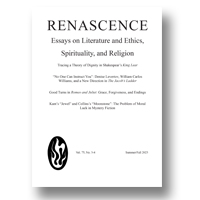|
2.
|
Renascence:
Volume >
68 >
Issue: 4
Anna Głąb
The Other as Text:
The Ethics of Love in Jeffrey Eugenides’s The Marriage Plot
abstract |
view |
rights & permissions
| cited by
Literary fiction is the most appropriate way of describing the phenomenon of love. It appreciates the uniqueness and preciousness of individuals, and it allows for universalizing. By following the experiences of Madeleine and Leonard, the main characters in Jeffrey Eugenides's The Marriage Plot, I focus on the problem of experiencing love through the lenses of different literary constructs. Following Raimond Gaita, I find that love is a reaction to the preciousness of human beings. Two particularly important aspects are sensitivity and the ability to react to the call of seriousness hidden in the declaration of love. I attempt to evaluate Madeleine's and Leonard's situation by means of the category of moral responsibility and self-awareness.
|
|
|
3.
|
Renascence:
Volume >
68 >
Issue: 4
Michelle Loris
Biblical Analogues in Joan Didion’s Play It As It Lays
abstract |
view |
rights & permissions
| cited by
Joan Didion uses Biblical analogues in her novel Play It As It Lays (1970) to recount the American western myth she learned in her youth, “the story that the wilderness was and is redemptive” (“Thinking about Western Thinking” 14). Her use of scriptural analogues helps us to understand the moral themes in this novel. Situating her novel in America’s most disappointing frontier —Hollywood, Didion uses the Biblical metaphor of the desert to relate a tale of moral chaos illustrated by failed marriages, sexual adultery, forsaken children, and suicide. In Didion’s scriptural analogues, we see, in this Hollywood story, a contemporary wilderness riven by spiritual despair and moral devastation, but a wilderness that can lead to deliverance.
|
|
|
4.
|
Renascence:
Volume >
68 >
Issue: 4
Franklin Arthur Wilson
Percy Following Faulkner:
A Different Path?
abstract |
view |
rights & permissions
| cited by
This article offers four views of Walker Percy’s fourth novel, Lancelot: [1] The novel echoes themes engaged by William Faulkner in two of his works, Sanctuary and Requiem for a Nun ; [2] Lancelot advances Faulkner’s particular assertion that the “past is never dead, it is not even past”; [3] as the novel’s epigraph suggests, Percy also writes Lancelot in relation to Dante Alighieri’s early 14th century poetic allegory, The Divine Comedy; [4] understanding Lancelot as an advancement of Faulkner’s view of history by means of Dante’s theology contradicts Shelby Foote’s memorial hope that Percy would be remembered “not merely [as] an explicator of various philosophers and divines,” but as a novelist in “simple and solemn fact.”
|
|
